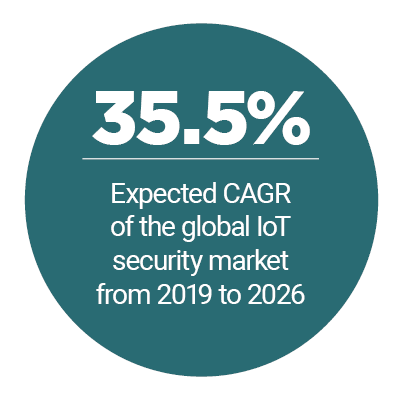Smart technology is unlocking supply chain efficiencies, providing emergency alerts and much more. But despite intelligence of things (IoT) solutions being put to use in many cases, the field continues to be hampered by security issues.
Researchers have continued to report simple issues that trip up the tech — including failures by device manufacturers to require users to set up a PIN or passcode or failures by users to securely implement the technology.
users to securely implement the technology.
The June IoT Tracker explores the latest advancements in IoT security and new applications of smart technology.
Around the IoT World
It’s not only device manufacturers’ lax behavior that exposes IoT to risk. A recent survey found that 85 percent of industrial sites have at least one device that can be remotely accessed. Particularly troubling is that more than 50 percent of sites use outdated Windows software to manage their industrial control systems, and 40 percent have unsecured, direct internet connections.
New security threats are emergi ng, too. Experts discovered a new Mirai botnet strain that had been identified earlier this year is now being wielded in attacks. The malware targets smart TVs and wireless presentation systems by exploiting their default credentials.
ng, too. Experts discovered a new Mirai botnet strain that had been identified earlier this year is now being wielded in attacks. The malware targets smart TVs and wireless presentation systems by exploiting their default credentials.
As users and manufacturers struggle to sufficiently secure connected solutions, companies are bringing IoT to more and more use cases. Amazon recently announced that it plans to go live with its drone-based eCommerce delivery plans this year. The company said it has designed the drones to use artificial intelligence (AI) to help it avoid telephone wires, people, pets and other obstacles.
Find all the latest headlines in the Tracker.
How The Z-Wave Alliance Balances IoT Interoperability and Security
 Consumers have a plethora of smart home devices to choose from when decking out their houses, and they’ll likely not want to be limited to one brand. Managing incompatible offerings is a friction-filled experience, and the need to spare consumers this pain helped inspire a group of IoT developers to form the Z-Wave Alliance back in 2005.
Consumers have a plethora of smart home devices to choose from when decking out their houses, and they’ll likely not want to be limited to one brand. Managing incompatible offerings is a friction-filled experience, and the need to spare consumers this pain helped inspire a group of IoT developers to form the Z-Wave Alliance back in 2005.
In this month’s feature story, Z-Wave Alliance executive director Mitchell Klein explains how the global consortium of more than 700 member companies works to ensure device security and interoperability. Plus, Klein addresses California’s new IoT security law and why the federal government should act now to release national smart device security legislation.
Get the full scoop in the Tracker.